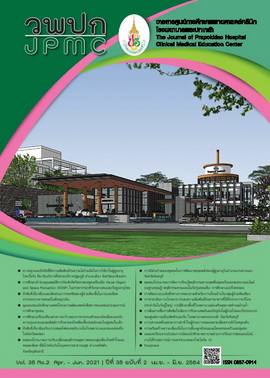Comparison of Red Cell Distribution Width with the Severity and Outcomes in Children with Community-Acquired Pneumonia
Main Article Content
Abstract
BACKGROUND: Community-acquired pneumonia (CAP) is the leading cause of death among children less than five years of age. Prognostic markers play an essential role in the proper management of CAP. Red cell distribution width (RDW) is a routine laboratory measure associated with poor outcomes in pneumonia.
OBJECTIVES: The aim of this study was to compare elevated RDW with the severity and outcomes in children with CAP.
METHODS: Medical records of all six-month – five-year-old patients admitted from January 1, 2015, to December 31, 2019, with CAP were retrieved. Demographic data, clinical characteristics, clinical respiratory score, laboratory records, and outcomes during hospitalization (transfer to the Pediatric Intensive Care Unit, treatment with mechanical ventilation, length of hospital stay, and death) were compared between the normal (≤14.5%) and high (>14.5%) RDW groups.
RESULTS: A total of 100 patients were included. The high RDW group (n = 45) had a significantly higher clinical respiratory score than the normal RDW group (n = 55) (3.2±1.5 vs. 2.1±1.1; p < 0.001). Moreover, the outcomes during hospitalization were not significantly different between the groups.
CONCLUSIONS: Elevated RDW displayed a significantly higher clinical respiratory score among pediatric patients with CAP.
Article Details
References
Walker CLF, Rudan I, Liu L, Nair H, Theodoratou E, Bhutta ZA, et al. Global burden of childhood pneumonia and diarrhoea. Lancet 2013 ;381(9875):1405-16.
Teeratakulpisarn J, Uppala R, Thepsuthammarat K, Sutra S. Burden of acute lower respiratory infection in children in Thailand in 2010: have we achieved the national target in under-five morbidity and mortality?. J Med Assoc Thai 2012;95 Suppl 7:S87-96.
Silva Litao MK, Kamat D. Back to basics: red blood cell distribution width: clinical use beyond hematology. Pediatr Rev 2018;39:204-9.
Braun E, Domany E, Kenig Y, Mazor Y, Makhoul BF, Azzam ZS. Elevated red cell distribution width predicts poor outcome in young patients with community acquired pneumonia. Crit Care [Internet]. 2011[cited 2019 Sep3];15(4):R194. Available form: https://ccforum.biomedcentral.com/articles/10.1186/cc10355
Said AS, Spinella PC, Hartman ME, Steffen KM, Jackups R, Holubkov R, et al. RBC distribution width: biomarker for red cell dysfunction and critical illness outcome?. Pediatr Crit Care Med 2017;18:134-42.
Sachdev A, Simalti A, Kumar A, Gupta N, Gupta D, Chugh P. Outcome prediction value of red cell distribution width in critically-ill children. Indian Pediatr 2018;55:414-6.
Gorelik O, Izhakian S, Barchel D, Almoznino-Sarafian D, Tzur I, Swarka M, et al. Changes in red cell distribution width during hospitalization for community-acquired pneumonia: clinical characteristics and prognostic significance. Lung 2016;194:985-95.
Yčas JW, Horrow JC, Horne BD. Persistent increase in red cell size distribution width after acute diseases: a biomarker of hypoxemia?. Clin Chim Acta 2015;448:107-17.
Lee JH, Chung HJ, Kim K, Jo YH, Rhee JE, Kim YJ, et al. Red cell distribution width as a prognostic marker in patients with community-acquired pneumonia. Am J Emerg Med 2013; 31:72-9.
Lee SM, Lee JH, Kim K, Jo YH, Lee J, Kim J, et al. The clinical significance of changes in red blood cell distribution width in patients with community-acquired pneumonia. Clin Exp Emerg Med 2016;3:139-47.
Miranda SJ. Validity of red cell distribution width as a predictor of clinical outcomes in pediatric patients diagnosed with pneumonia. Chest [internet]. 2017 [cited 2020 Mar 6]; 152(4 Suppl): A843. Availeble form: https://journal.chestnet.org/article/S0012-3692(17)32395-4/pdf
Nayani K, Naeem R, Munir O, Naseer N, Feroze A, Brown N, et al. The clinical respiratory score predicts paediatric critical care disposition in children with respiratory distress presenting to the emergency department. BMC Pediatr [Internet]. 2018 [cited 2019 Sep 17];18(1):339. Availeble form: https://bmcpediatr.biomedcentral.com/articles/10.1186/s12887-018-1317-2
Ramby AL, Goodman DM, Wald EL, Weiss SL. Red blood cell distribution width as a pragmatic marker for outcome in pediatric critical illness. PLoS One [Internet]. 2015 [cited 2020 Feb 4];10(6):e0129258. Availeble form: https://journals.plos.org/plosone/article?id=10.1371/journal.pone.0129258
Zurauskaite G, Meier M, Voegeli A, Koch D, Haubitz S, Kutz A, et al. Biological pathways underlying the association of red cell distribution width and adverse clinical outcome: results of a prospective cohort study. PLoS One[Internet]. 2018 [cited 2020 Aug 27];13(1): e0191280. Availeble form: https://journals.plos.org/plosone/article?id=10.1371/journal.pone.0191280

